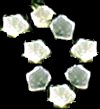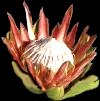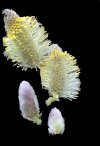|
**disclaimer: If any of the images belong to you and if you want credit or want them removed please email me**
MEANINGS & LEGENDS OF FLOWERS (P)

 Pansy
Pansy
Viola cornuta
Family: Violaceae
Common Names: ~Hearts-ease~ ~Tickle-my fancy~
Pansy is a type of violet. Taken from the French word ~panse,~ it meant ~romantic thought~ to the Victorians. Pansy was one of the ingredients in a Celtic love potion. Pansy was supposed to have magical love powers. The petals being heart-shaped, were thought to cure a broken heart.
According to a German legend the pansy once had a wonderful, strong scent. People came from miles to smell the flower. By doing this the people would destroy the grass around the pansies. The pansy prayed to God for help because the feed for the cattle was being trampled. God took the scent of the pansy away, but gave it great beauty instead.
Pansy is associated with St. Valentine's Day and has long been exchanged by lovers. According to legend, pansies should not be picked while the dew is upon them, for that would cause the death of a loved one, with as many tears shed before the next full moon. Attesting to this was William Shakespeare when speaking of the pansy in ~A Midsummer Night's Dream,~ with pansy juice on her eyes, sleeping Titania fell in love with the first creature she saw when she awoke.

 Parsley
Parsley
Petroselinum crispum
Family: Umbelliferae/Apiaceae (carrot family)
Common Names: ~Italian Parsley~ ~Hamburg Parsley~ ~Turnip-rooted Parsley~
Parsley has been cultivated since the 3rd century BC. It spread to the Americas in the 17th century and is one of the most widely used culinary herbs in the United States. It's Latin name Petroselinum comes from Greek ~pétros~ meaning ~rock~ or ~stone.~
Parsley is one of the essential plants in a witch's garden. According to medieval legend, parsley seeds went to the devil nine times and back before they germinated. That belief stems from the earlier Greek belief that parsley seeds visited the underworld nine times before sprouting.
Parsley was dedicated to Persephone, the wife of Hades and Queen of the Underworld. Tombs were decorated with parsley wreaths, and these wreaths were also awarded to the winners of the Nemean games, which were the descendants of funeral games commemorating the death of important personages. Chrysippus thought that eating parsley was a sin, since parsley honored the dead at funeral feasts. The Greeks used the phrase ~to be in need of parsley~ to denote someone who was close to death.
In England it was believed that:
Parsley grows for the wicked, but not for the just.
A parsley field will bring a man to his saddle and a woman to her grave.
When parsley's grown in the garden, there'll be a death before the year's out.
To dream of cutting parsley is a bad omen as the dreamer will be ~crossed in love.~
In Devonshire it's believed that transplanting parsley brings bad luck and the owner or his family will be punished within the year.
Medieval Europeans believed that one could kill an enemy by plucking a sprig while speaking the person's name.
The Romans and the ancient Greeks used Parsley as a garnish and flavoring. They put it around their necks during banquets for it was thought to absorb the fumes of the wine. It was placed on plates to protect the food from contamination and used in baths for purification and keeping misfortune away. The Romans believed parsley could prevent intoxication and were the first people to consume it in large quantities.
It takes twelve pounds of fresh Parsley to make one pound of dried. Dried Parsley is used as a garnish in soups, meats, vegetables, and sauces. Parsley is a great cleansing herb. Pregnant woman should not use parsley for it may bring on an early labor, and it is not suitable if one has kidney problems. Parsley tea is refreshing and chewing the sprigs relieve indigestion and urinary problems. The roots are more powerful than the leaves. For insect bites, squeeze parsley juice onto the sting for a quick relief. Infuse parsley into a lotion to help clear freckles.

 Pasque
Pasque
Anemone pulsatilla
Family: Ranunculaceae
Common Names:~ Pasque Flower~ ~Wind Flower~ ~Meadow Anemone~ ~Passe Flower~ ~Easter Flower~ ~Shamefaced Maiden~
Pasque Flower grows wild in dry soils of Central and Northern Europe. Anemone pulsatilla, comes from the Greek word ~atienios~ meaning ~itching~ and from the Latin ~pulsate~ meaning to ~beat or to strike~ because the flowers ~pulsates with the wind~ so the name ~pulsatilla.~
It was used to colour the Paschal eggs in some countries. The juice of the purple sepals gives a green stain to paper and linen, but it is not permanent. Eggs were boiled with pulsatilla flowers to dye them green for spring festivals. The custom was later adopted by Christians for coloring Easter eggs and since the flowers appear traditionally during Easter time, it got it's English name ~Pasch~ or ~Pasque Flower.~ Another popular English name for the plant is ~Shamefaced Maiden.~
It was first used by Arabian physicians as a external application for ulcers, for the inflammation of eyes, toothache and headache. It was introduced into homoeopathy in 1805. The plant has a strong acrid taste, but is eaten by both sheep and goats, though cows and horses do not touch it.

 Passion Flower
Passion Flower
Passiflora incarnata
Family: Passifloraceae
Common Name: ~Wild Passion Flower~ ~Wild Water Lemon~ ~Love-in-a-mist~ ~May-pop~ ~ Grandilla~ ~Maracoc~ ~Passion Vine~ ~Apricot Vine~
The colloquial name for this plant is ~May-pop~ which refers to the tendency for its edible fruit to pop when stepped upon. It is a woody vine which bears small berry-like fruit called ~Granadilla~ or ~Water Lemon.~ Passion Flower is unique among the old religious flower symbols because it focused on Christianity and also provided a visual means of teaching the Gospel in an era where there were no printed materials. Passionflower blossoms have been used as a meditative aid. The flower can be hypnotic.
Historically it has been associated with Jesuit priests, in South America during the early 17th century. The symbolism of the Passion Flower, a native genus of the tropical Americas, was discerned by a Mexican Augustinian Friar Emmanuel de Villegas, who reported it in Europe in the year 1610.
It includes the following:
The spiraled tendrils - the Lash of Christ's Scourging
The central flower column - the pillar of the Scourging
The 72 radial filaments - the Crown of Thorns
The top 3 stigma - the 3 Nails
The lower 5 anthers - the 5 wounds
The leaves - the head of the Centaurian's Spear
The red stains - Christ's Blood Drops
The Round Fruit - The World Christ came to save
Early Americans applied the crushed leaves as a poultice to treat bruises. They also brewed the woody vines and drank the tea to soothe their nerves. It was used as a tranquilizer to treat insomnia, fatigue, tension, and muscle spasms. It seems to have a narcotic like effect when taken internally. The Passionflower has no known toxicity but it should be used conservitively.

 Hawaiian name: Pa'u-o-Hi'iaka
Hawaiian name: Pa'u-o-Hi'iaka
Jacquemontia sandwicensis
Family: Convolvulaceae
Indigenous to Hawaii, this plant also grows in Mexico, the West Indies, and Africa. Meaning ~Skirt of Hi'iaka~ this coastal vine has pale blue flowers. Legend tells us that the Goddess Pele returning to the beach from a lengthy fishing trip found that the vine had spread over her baby sister, Hi'iaka, protecting her from the sun's rays.
Ancient Hawaiians used the leaves and stems medicinally as a cathartic and to treat thrush.

 Peace Lily
Peace Lily
Spathiphyllum sp.
Family: Araceae
Common Name: ~Spathiphyllum~ ~White Flag~
Hawaiian name: Nana-honau'
Evergreen perennials native to Malaysia, Colombia and Venezuala. The name Spathiphyllum comes from the Greek ~spathe~ meaning ~bract~ and ~phyllon~ meaning ~leaf~ due to the flowers being leaf like in shape.

 Peony
Peony
Paeonia lactiflora
Family: Paeoniaceae
Common Names: ~Plant of Healing~ ~Happy Life~ ~Prosperity~
Peony is named for Paeon, a deity of healing. Paeon was a student of Asclepius, the god of medicine and healing. He was instructed by Leto (Apollo's mother and goddess of fertility) to obtain a magical root growing on Mount Olympus that would soothe the pain of women in childbirth. Asclepius became jealous and threatened to kill his pupil. Zeus saved Paeon from the wrath of Asclepius by changing him into the peony flower. Peony seeds were used on pregnant women in ancient times.
The Peony represents the Royal Families of China. They call it the ~Sho-yo~ which means ~medicinal herb plant~ The root of ~Sho-yao~ was what first interested the Chinese. It is the ~flower of prosperity~ and is a symbol of wealth and beauty. There is a legendary story about a peony from the Temple of Sorim, NakYang. Queen Mu had a party in the capital city of Jang-Ahn. The Queen wanted show her authority and ordered all the flowers to bloom at the same time inorder to make her happy. All the flowers obeyed, except for the peony. The Queen was so angry that she had it sent away to the country side, NakYang. Strangely, as soon as the peony arrived in NakYang, it bloomed beautifully. When the Queen heard this she was enraged and ordered it burned. Even after burning, the peony bloomed. Based on this legend, the peony became the symbol of loyalty among Chinese. The Japanese apricot has been the symbol of China, since Mao Tse-tung's army started the revolution.
The earliest record of the peony was found in 1972 in a first century tomb. On one of the bamboo slips, a prescription was written: using the skin of the tree peony’s root. A famous painter, Gu Kaizhi (345-406), painted a garden scene with tree peonies in the background. During the time of Emperor Yang of the Sui Dynasty (605-618), we find in recorded history that a tribute of 20 cases of tree peonies of various names in red and yellow were presented to the Emperor.
From the Tang Dynasty to the end of the Sung Dynasty (618-1279), the tree peony enjoyed great prestige. It was the favorite flower from the imperial court down to the common folks. Calling it the ~King of Flowers~ was initiated in the Tang Dynasty (618-907). A poet wrote "Only the tree peony is worthy of being called the Beauty of the Empire." People were enthralled by the tree peony. Poets wrote poems, musicians composed songs, artists painted pictures, and writers wrote articles about it. One of the most valuable articles preserved till today is Ouyang Xiu’s (1007-1072), Record of the Tree Peony in Luoyang. In this article he listed 24 kinds of tree peonies and described them one by one. Today, several in this group are still in existence and treasured by flower lovers in China.
Peony is the flower of June in Japan, symbolizing ~hands full of cash.~
On March 13, 1957, the peony became Indiana’s 4th state flower.

 Pennyroyal
Pennyroyal
Mentha pulegium
Family: Labiatæ
Common Names: ~Pulegium~ ~European Pennyroyal~ ~Pudding Grass~ ~Lurk-in-the-Ditch~ ~Run-by-the-Ground~
Pennyroyal, a bitter-tasting mint whose flavor is no longer popular. In former times, it was used as a flavoring for puddings and sauces.
Barley meal mixed with water and pennyroyal, was the drink that Misme served to Demeter during her long search for Persephone. This became the ritual drink of the Eleusine Mysteries.
It is used for strength, peace and protection. Pennyroyal has been used for centuries as a flea repellant. It was also used to induce abortion. It was also used as a contraceptive in ancient times. It also kept bees from flying away when placed into a container with them.
Several tribes of North American Indians used the American species of Pennyroyal, Hedeoma pulegioides, for various ailments. The Chickasaws soaked the plant in water and placed it on the forehead to relieve itchy and watery eyes. The Mohegans drank pennyroyal tea to cure a stomach ache, and the Catawabas used the tea as a cold remedy. Many white settlers learned of these remedies from the American Indian Healers. Both the Indians and the settlers rubbed the leaves against their skin to repel insects. Pennyroyal is called pudding grass because it was used to flavor haggis.
It is considered a sign of hospitality. In the language of Flowers it means to Flee away/Go away.

 Protea
Protea
Protea Cynaroides
Family: Proteaceae
Originated in Australia, Southern Africa and South America. According to Botanists, Protea are one of the oldest flowers on the earth, known to exist in prehistoric times. It has more than 1,400 different varieties. As a family, proteaceae is so diverse that it did not receive a botanical name until 1735.
Protea was named after the Greek mythological sea god Proteus, who herded seals for Poseidon and could assume many different shapes at will.
Associated with the star sign Aquarius. Proteas are suitable for drying. They have a vase Life of 7 to 10 days

 Poinsettias
Poinsettias
Euphorbia pulcherima
Family: Euphorbiaceae
Common Names: ~Flower of Christmas Eve~Flame Leaf~ ~Flower of the Holy Night~
Known by its Spanish name ~Flor de nochebuena~ Poinsettias are native to Mexico. There are over 100 varieties of poinsettias available. William Prescott, a historian and horticulturist named the plant the poinsettia after America's first ambassador to Mexico, Joel Poinsett who brought the plants to America in 1828.
The botanical name, Euphorbia pulcherrima, was named by the German botanist, Wilenow. The plant grew through a crack in his greenhouse. Dazzled by its color, he gave it the botanical name, Euphorbia pulcherrima meaning ~very beautiful.~
In the early 1900's the Ecke family of southern California grew poinsettias outdoors for use as landscape plants and as a cut flower. Eventually the family grew poinsettias in greenhouses and today are recognized as the leading producer of poinsettias in the United States.
The Mexicans in the 18th century thought the plants were symbolic of the Star of Bethlehem and the Poinsettia became associated with the Christmas season. Poinsettia plants are traditionally given at Christmas. Their leaves are pink, white or red.
According to Mexican legend, a child knelt before the altar at his village's church on Christmas Eve. Since he had no money, he could not get a gift to offer to the Christ Child on his birthday. His prayers were sincere, and through a miracle the first ~Flower of the Holy Night~ bloomed at his feet. This was the birth of the Poinsettia.
Another story goes that a poor Mexican child on her way to church on Christmas Eve wept because she had no gift to offer the Christ Child. Through her tears, an angel suddenly appeared and instructed her to gather weeds from the roadside. When the child arrived at the altar with her wilted offering, starry crimson blossoms burst forth from every stem.
The poinsettia's brilliant display is produced by colored bracts surrounding the real flowers, which appear as a cluster of yellow berries called cyathia. The petal-like bracts are modified leaves located at the junction of the flower stalks and main stem. The actual flower of the poinsettia is small and yellow but surounding the flower are large, bright red leaves, often mistaken for petals.
The Aztecs called poinsettias ~Cuetlaxochitle.~ During the 14th - 16th century the sap was used to control fevers and the bracts were used to make a reddish dye.
Poinsettia are known as the ~Crown of the Andes~ in Chile and Peru and ~Lobster Flower~ and ~Flame Leaf Flower~ in Central America.
December 12 is National Poinsettia Day. Poinsettias represent over 85 percent of the potted plant sales, worth about $220 million, during the holiday season in the Unites States. The cost of a poinsettia is determined by the number of blooms. Ninety percent of all poinsettias are exported from the United States of which California is the top poinsettia producing state.

 Polygonum
Polygonum
Polygonum bistorta L.
Family Polygonaceae
Common Names: ~Bistort~ ~Dragon's Wort~ ~Snakeweed~ ~Serpentary~ ~Snake Root~ ~Adderwort~ ~Osterick~ ~Passions~ ~Easter Ledges~
Bistort means ~twice-twisted~ because it's root which is a stout, twisted, reddish-brown horizontal rhizome.
In the Language of Flowers it signifies Horror. It is used for divination and trance work. The root is used as a charm and if carried near the breast, it helps those vexed with frenzy. It is supposed to heal passions and gives a person who touches it the virtue of their sign or planet. Leaves and young shoots were used in Herb Pudding in the Middle Ages.

 Poppy
Poppy
Papaver rhoeas
Family: Papaveraceae
Poppy comes from the Greek word ~rhoeas~ meaning ~red.~ Papaver is Latin, meaning ~pap,~ the opium poppy's milky juice. Oriental poppies contain opium which has been used for centuries. The corn poppy does not contain opium.
Poppies were found in Egyptian tombs dating back 3,000 years. According to the Romans the poppy could heal a love wound and they used it for witchcraft. The ancient Greeks used poppies as a love charm and thought that they were a sign of fertility and brought health and strength so Greek atheletes were given mixtures of poppy seeds, honey, and wine.
According to Greek legend, the poppy was created by Somnus, the god of sleep, to help Ceres, the corn goddess, who was exhausted by the search for her lost daughter that she couldn't make the corn grow. The poppies soothed her to sleep, and when she rested, the corn grew again, giving rise to the belief that the presence of poppies was essential to grow corn.
Demeter,so the legend goes, created the poppy for the purpose of getting some sleep after the loss of her daughter Persephone. The twin brothers Hypnos and Thanatos (Sleep and Death) were represented as crowned with poppies or carrying poppies in their hands. Obviously the Greeks were aware of the fact that a merciful sleep induced by opium could lead to death.
Another story about the poppy tells us that a bad witch had transformed a woman into a poppy. From that day on the woman lived on the field with the other poppies and was allowed to visit her family only at night time. One night the woman told her husband that if the next day he will pick her poppy the spell will be broken. In the morning the man went to the field and saw hundreds of poppies there, all looking alike. After looking at each of them, the man knew which one was his wife because that poppy was the only one not wet by the morning dew, since the woman had spent her night at home. When he picked that poppy the spell was broken and they lived happily ever after.
In New Zealand the term ~Tall Poppy~ is used to describe people who stand out above all others. The ~Welsh Poppy~ is yellow. ~Corn Rose~ was the name given in Roman times to the wild Poppy, which was often found growing in fields of corn. ~Smoke of the Earth~ is the name given in the Middle Ages to the Poppy. The smoke of the burning plant was said to cast out evil spirits.
The poppy was noticed during the Napoleonic Wars, as the mysterious flower that bloomed around the fresh graves of fallen soldiers. After the 1914-18 war the shell holes, and graves on the battlefields in Flanders, filled with poppies. The Poppies were said to have come from the spilt blood of war. It is an emblem that commemorates those who died in wars.
It was known to the Assyrians and was introduced into England by the Romans. Christianity gave its symbolism a new twist. Carved into the benches of some medieval church pews it represented the belief that we rest in anticipation of the Last Day.
The plant has many healing qualites apart from that of narcotic. Morphine and Codeine are two familiar drugs made from the poppy. Opium was also the main reason for England's war with China in 1839. For centuries opium has been cultivated in India.
Canadian doctor, Lt.-Col. John McCrae, immortalized the poppy in his famous poem In Flanders Fields.
After the war, an American, Moina Michael, began wearing a poppy in memory of the war dead.
Dorothy fell asleep in a field of poppies in the Wizard of Oz.

 Hawaiian name: Pua-kenikeni
Hawaiian name: Pua-kenikeni
Fagraea berteriana
Family: Loganiaceae
Native to the South Pacific the Pua keni keni grows into a small spreading tree or a large shrub. It has fragrant, tubular shaped white flowers which turn golden orange. Flowers are popular for making Lei's and the Hawaiian translation means ~ten cent flower~ which is what the flower once sold for.
According to Tahitian legend this plant originated from the Tenth Heaven. Its fragrant flowers were used by the Polynesians to perfume coconut oil.

 Purple Sweet Potato
Purple Sweet Potato
Ipomoea batatas
Family: Convolvulaceae Juss.
Common Names: ~Sweet potato~ ~Kumara~ ~Uwi~ ~Ubi~ ~~Yam~
Hawaiian name: 'Uala
Sweet potato is an important crop of the Pacific islands for centuries. It was a staple in the diet of the Maoris of New Zealand. The name ~Kumar~ is used for this plant in Peru.
According to legend, Rongo ma-Tane, a Maori god, protects this plant; the buried tuber is said to be very powerful that it can make an enemy mad and run away.
It is said that the Hawaiian God, Kane Puaa, had a snout-like nose like the sweet potato. In Japan and Taiwan, it is dried and stored as ~typhoon insurance.~ Japan leads in production of sweet potatoes, and throughout the Orient this tuber is a common table vegetable.

 Primrose
Primrose
Primula vulgaris
Family: Primulaceae
Common Names: ~Virgin Mary's Cowslips~ ~Cowslip~
Primula comes from the Latin prima which means ~the first~ and indicates that the flowers lead the parade of spring blooms.
The goddess Bertha is supposed to entice children into her enchanted halls by offering them beautiful primroses.
The ~mysterious number~ of primrose petals represents woman. The five petals represent birth, initiation, consummation, repose, and death.
The whole plant is sedative. In ancient cookery the flowers were the chief ingredient in a pottage called ~Primrose Pottage.~ Another old dish had rice, almonds, honey, saffron, and ground Primrose flowers. A wash of Cowslip water will improve the complexion.
Primrose is associated with Freya, and it is said to open the door to her hall or mound.
*See Cowslip

 Pussy Willow
Pussy Willow
Salix discolor
Family: Salicaceae
In ancient Europe Pussy Willow rods and branches with leaves were called ~Rods of Life.~ The Mysteries of the Roman goddess, Libra, included initiating women into motherhood by ritual flogging them with the Rod of Life to ensure fertility. Poles and Ukrainians struck one another with pussy willows on Palm Sunday, a custom called ~God's Wounds~ in remembrance of the scourging of Jesus.
The Pussy Willow, provides a compound called ~salicin~ which is similar to the active ingredient in most painkillers. Native North Americans extracted it from the bark and roots for a painkiller and anti-fever medication.
|


Copyright © Pinkie D'Cruz 1998
Friday, January 16, 1998


|
